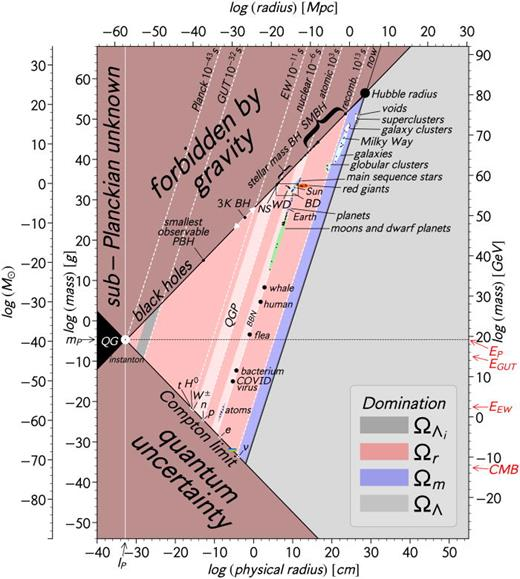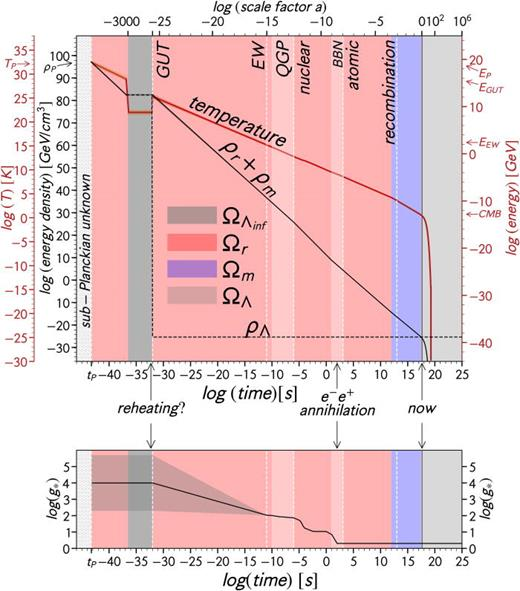It seems such a simple idea it’s surprising no one has done it before: plot everything from subatomic particles to superclusters on a chart of mass and radius. Now that someone has, the results raise some very intriguing, and possibly a little disturbing, questions.
The chart is the work of Dr Charles Lineweaver and graduate student Vihan Patel. They used a log-log graph, because nothing else could cover the many orders of magnitude in both size and mass between the very small and the very large. Certain areas are “forbidden” by known laws, or where “quantum mechanics blurs the very nature of what it really means to be a singular object,” Patel said in a statement.
Perhaps the most significant part of the chart is the black line that separates the area marked as “forbidden by gravity” from the space populated by familiar objects. Along this line are dotted black holes. “The larger the mass of a black hole the lower its density,” Lineweaver explained to IFLScience. Although the leftward part of the line is theoretical, scientists have observed a range of black hole sizes from remnants of collapsed stars to the largest supermassive black hole, and this pattern is established and understood.

A logarithmic graph of the mass and radius of all categories of objects in the universe, and the forbidden areas around them.
However, following the line upwards we learn that the entire observable universe – the area that sits within the “Hubble radius” is also on that line. In other words, if a black hole was as large as the universe we can see, it would have the same density as the universe. Is the universe then a black hole? And if so, what does that mean?
Lineweaver noted to IFLScience that he and Patel are not the first to ask if the whole universe could be a black hole, although others have reached the idea through different means. The idea seems improbable, but the pair note the universe has always been on the line. Their measure of mass includes dark matter and dark energy (since energy and mass are interchangeable). As the universe within the Hubble radius has grown in size, so has the total mass/energy thanks to increasing dark energy. The fact the universe was also on the line billions of years ago when the Hubble radius was much smaller makes it less likely its position on the line is a coincidence.
Lineweaver notes there is an event horizon around the observable universe, just as there is around a black hole, and this is just one of the parallels between them.
However, Lineweaver also stressed that the universe being a black hole requires the assumption everything outside the Hubble radius is a zero density Minkowski space (vacuum to most of us). Most cosmologists, including Lineweaver, think this is a bad assumption, he told IFLScience, leaving the implications of his chart unclear. “The universe could be an inside-out black hole,” he added. All told, he thinks the question requires significantly more thought.
An obstacle to answering whether the universe is a black hole, or at least something related to it, is that we don’t know what the inside of a black hole is like. “Nothing can exist to the left [of the black hole line],” Lineweaver told IFLScience. “But isn’t the center of a black hole likely to be denser than the black hole itself? We don’t know anything about the center.” As Stephen Hawking and Roger Penrose pointed out, general relativity and quantum mechanics give different answers to questions like this, and the tension has not been resolved.

As a stepping stone to the chart above the authors plotted the age of the universe against temperature, to identify the time at which things could form.
The chart also raises questions about the nature of the universe’s beginnings. “At the smaller end, the place where quantum mechanics and general relativity meet is the smallest possible object – an instanton,” Patel said. “This plot suggests the universe may have started as an instanton, which has a specific size and mass, rather than a singularity, which is a hypothetical point of infinite density and temperature.”
Although the term “singularity” is much more associated with the Big Bang in the public imagination, Lineweaver told IFLScience people should become more familiar with instanton, which he considers the more plausible model for the universe’s origins.
The study is published open access in the American Journal of Physics.
Source Link: The Observable Universe Might Be A Black Hole, Suggests A Chart Of Everything